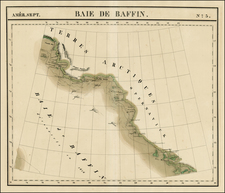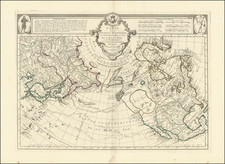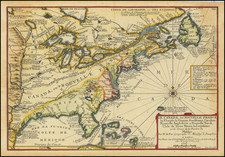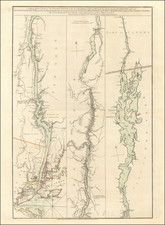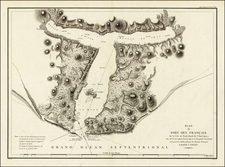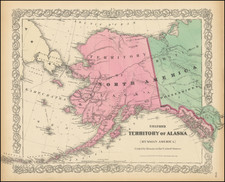Unrecorded Klondike and Indian River Gold Rush Map with Manuscript Connections To Investment Fraud & Murder
An apparently unrecorded map of the Gold Mining Regions in Alaska and the Yukon, with contemporary manuscript notes and a connection to a famous fraud and murder case, wherein a well regarded Manitoba politician was the victim of a scheme to defraud him of his claims on the Indian River, which led to his murder in Berkeley in 1903.
While the map is undated, we assume it must have been prepared in or about 1898, with manuscript additions added shortly thereafter, as the combined product is vastly more detailed and in a larger format then that of the Klonidike and Indian River Gold Rush maps produced in 1898. The Wallace Map and the Tappan Adney map report very little information on or south of Indian Creek. On the present map, three major tributaries have been added south of Indian Creek in manuscript and a fourth has been significantly extended.
The map extends from Dawson and the Klondike River in the north to Indian Creek in the South, the location of extensive manuscript annotations in red ink and pencil. The map is an exceptionally detailed cartographic record of the mining operations, trails, outposts and settlements in the Klondike region of the Yukon, locating rivers, creeks and trails at a level of details which is quite remarkable for the period.
The key on the map references Roads, Trails, Gold Discoveries and dozens of Road Houses along the actively mined rivers and creeks in the region.
One of the more curious features to the map is that it shows Eureka Creek flowing in a southwesterly direction. However, the creek actually flows in a southeasterly direction.
In addition to the printed details shown, it shows in red pen, the claims of Captain Thomas Howard, whose apparently valuable claims on the Indian River ended with his murder in Berkeley, California, after he discovered a scheme to defraud him of his valuable mining claims on the Indian River, a case which became famous at the time in San Francisco and elsewhere.
The annotations apparently reveal Howard's intentions to build a townsite and dam above his mining claim.
The map was clearly in the hands of someone making a detailed survey of the Indian River and most notably the area below the confluence of Sulphur Creek and Indian River, where there are significant additions showing mining areas, dams, new rivers, unnamed mountain peaks and a host of other details.
The map also includes annotations noting important elevations along the course of the primary rivers feeding into the Indian River, etc., including the heights at:
- "The Dome" (4,250 feet)
- Dawson (1200 feet)
- Confluence of Dominion Creek (Indian River) and Gold Run Creek (1972 ft)
- Confluence of Dominion Creek (Indian River) and Sulphur Creek (1906 ft)
- Confluence of Indian River and Australia Creek (1803 ft)
- Confluence of Indian River and Eureka Creek (1702 ft)
- Confluence of Indian River and Toronto Creek (1544 ft)
- Confluence of Indian River and Ninemile Creek (1410 ft)
- Confluence of Indian River and Yukon River (1233 ft)
The map notes in manuscript several areas of interest, including:
- Captain Thos Howard's Hydraulic Leasehold
- Captain Thomas Howard's Townsite and a damsite up river
- The distance between several points on the Indian River above Howard's townsite.
- Highland Mary Group
- Conglomerate Area on McKinnon Creek, Coal Creek and Montana Creek
- Several Coal beds west of the Conglomerate Area
We found references to the Highland Mary claim being surveyed and approved on July 31, 1900.
The McKinnon conglomerate bed in the Indian River area was mined as early as 1899 at McKinnon Creek.
The Indian River is along the original Klondike trail connecting Whitehorse to Dawson. Established in 1899, this trail was used primarily in the winter by prospectors enroute to the Klondike. The McKinnon Brothers arrived in the Klondike as seasoned prospectors and located the Britannia claim in 1899 on gold bearing quartz pebble conglomerate. Initial success and rumors attracted many other prospectors who staked claims and excavated numerous pits, adits and shafts around McKinnon and Ruby Creeks. The McKinnon brothers persisted in lode gold exploration at McKinnon Creek until their deaths.
Captain Howard's Claim is directly north of Eureka Creek, where a discovery is noted on the map. This area had become an important location, so much so that the miners and others on Eureka petitioned for a Royal Northwest Mounted Police detachment, which was established in 1901, with one non-commissioned officer and two men. Several buildings were erected. It remained staffed until 1903.
Captain Thomas Howard
Thomas Howard (1845 - 1903) was a political figure in Manitoba. He represented St. Peters from 1871 to 1874 and St. Clements from 1874 to 1878, in the Legislative Assembly of Manitoba.
He was born in Kingston, Ontario, the son of Dr. Henry Howard, and was educated in Montreal. Howard came to Manitoba as captain and paymaster with Wolseley's Red River Expeditionary Force in 1869. He served in the Manitoba cabinet as Minister of Agriculture, Minister of Public Works, Provincial Secretary and Provincial Treasurer. Howard was also secretary for the Board of Health for Manitoba and the North-West Territories, a founding member of the Winnipeg Board of Trade in 1873 and a director for the Manitoba and Northwestern Railway.
For his service, at the outset of the Klondike and Indian River Gold Rush, Captain Howard was granted mining rights on 1600 acres on the Indian River.
In, The Tragedy of the Klondike : this book of travels gives the true facts of what took place in the gold-fields under British Rule, (Luela Day, 1906), the author provides the following story at pp 135-36:
About this time Captain Thomas Howard, an old war-horse in the Kiel rebellion, who was a guest in the Melbourne Hotel, where I was still staying, and who owned a concession on Indian River, had told me it had been given to him by the government; that it was his plum which he had demanded and received from Clifford Sifton, Minister of the Interior. The concession had prospected well, and he had been offered $240,000 for the property, which, as he told me, the government wanted him to turn back, but, said he, "I will never do it." One morning he made ready and started in a two-horse conveyance to his property in company with Captain Norwood, who was representing Mr. Laurier, Prime Minister of Canada, in the mines, and a strange man who Howard told me was represented to him as being a civil engineer. They wanted him to point out the boundary lines of his property, and had promised him the money as soon as the conveyance could be arranged.
It was about sixty miles from Dawson to the Indian River concession, which lay in the interior of the Territory. When he had been gone less than forty-eight hours he returned alone, and came into my office in the hotel. He seemed very much agitated about something.
I said to him, "Captain, you surely have not been to Indian River and back so soon?"
He replied, "No. I want to tell you something. I think those people were taking me out there to kill me. I did not like the looks of that strange man, and do not believe he is a civil engineer."
I told him surely it could not be so bad as that.
He replied, "Ah, I am older than you are and am on to all such tricks. I got suspicious and came back, leaving them at a road-house."
In about three weeks Captain Thomas Howard received a telegram saying if he could come to the Russ House, in San Francisco, the deal for his concession could be consummated. I saw the telegram. He went forthwith. He landed safely at the Russ House, and shortly after, one evening, stepped out of the hotel to call upon a young physician who he told a friend had just come from Dawson. He was never seen alive again. His dead body was found in an alley behind a livery-barn two miles away from the Russ House.
The full story of Captain Howard's saga was the subject of an artice in the San Francisco Call, July 25, 1903, shortly after his death:
HOWARD'S DEATH REVEALS CONSPIRACY OF ENEMIES
CAPTAIN THOMAS HOWARD of Victoria, B.C., whose body was found with two bullet holes in the head and a fractured skull, behind a barn in West Berkeley last Saturday, was the victim of a manifest fraud on the part of New York speculators. For a year he had fought to retain rich mining claims in Alaska, He had expressed the fear, that he would be shot by an agent of his defrauders. He dared not walk the streets after dark.
Papers of Deceased Disclose Details of Fraud -- Days Before His End He Voices Fear of Assassins.
THE mystery surrounding the death of Captain Thomas Howard, whose bullet-riddled body, found just a week ago behind a barn in West Berkeley, has assumed proportions of astounding magnitude. From Dawson City to New York there stretches a web of evidence fraught with significance.
During the last year Captain Howard was the victim of a gigantic fraud, upon the successful consummation of which would have depended the loss of property of almost unlimited value. Over his own signature he had confessed himself wary of one of the conspirators against him who had once killed a man and would not hesitate to shoot him. During his entire stay in San Francisco he would not go out on the Streets after dark unaccompanied.
On Saturday last he was found lying beside Brennan's barn in West Berkeley with two bullet holes through his head and a frightful fracture of the skull. From the papers of the dead man now in the hands of the Coroner at Berkeley, there Is gleaned a story which may throw a strong light upon the tragedy which was enacted in the dark hours of the night behind the lonely barn in West Berkeley. They show the stake for which Captain Howard was fighting and incidentally how his death might facilitate the plans of those who were seeking to lay their hands on the prize.
RICH CLAIMS THE PRIZE.
Captain Howard was the possessor of 1600 acres of mining property situated on Indlan River, in the heart of the richest gold fields of the Klondike district. This had been awarded to him by the Government of British Columbia as a reward of meritorious services rendered in the Red River rebellion of 1869. It Is about this that there is hinged the drama which had its climax behind Brennan's barn In West Berkeley.
By the dead man's papers, now in the hands of the authorities, it Is shown that in December, 1901, he was in New York endeavoring to form a company to work his concession on the Indian River. Through his attorney. George P. Clay, whose office Is at 133 Broadway, he became introduced to a speculator by the name of Daniel F. Coholan of 271 Broadway.
Coholan became interested In Captain Howard's scheme, and, organizing a company from among a group of wealthy financiers, prepared to consider Captain Howard's offer. In a copy of a letter addressed to Coholan it appears that Howard asked that a necessary working caiptal be secured and that he be paid $50,000 as soon as the corporation was formed.
On February 21, 1902, Coholan wrote to Howard saying that "his clients were prepared to purchase the claim on the Indian River on the terms asked, providing "that an investigation of the claim proved that it was as valuable as represented."
"John H. 'Mangham of 49 Wall street, New York City," also appears to have been interested in the purchase of Howard's land. During. February, 1902, Mangham wrote letters to Howard saying he would do all he could to help Howard sell the claim to Coholan.
The correspondence then shows that there was a slight delay in carrying out the purchase of Howard's mining claims. According to some of the letters Coholan had doubts that Howard 's title to the property was a clear one and it is suggested that Howard go to Ottawa, Canada, and secure proof of his title to the claim from the Canadian Minister of the lnterior.
On April 14,1902. a letter was sent from the Department of the Interior at Ottawa, Canada, to Barrister Chrysler of that city, stating that the mining claim on the Indian River had been leased to Captain Howard and that no 'ease for the property had been issued, to any other person. The department also wrote, that the assignment of the claim by Howard to Coholan .had been approved and entered on the'Records.
Coholan seems to. have reached an agreement with Captain Howard on March 22, 1902, when a compact was entered into whereby the New York financier was to put up a certain sum as a guarantee of good faith, and pay the expenses of Captain Howard and a mining expert to the Klondike. If it was demonstrated that the property was not what its owner claimed it to be Coholan was to have the privilege of a right of sale.
The expert chosen was George L. Taylor of 14 West Twelfth street, New York. With him Captain Howard left for Dawson, arriving there on June 24.
SUSPICIONS AROUSED.
From the correspondence both in writing and in cipher telegram which passed between Captain Howard and his attorney during, the next few months it becomes evident that the former thought himself the victim of a gigantic fraud, the result of which would be to rob him of his concession. That his belief was well founded is attested by letters from legal advisers. His first suspicions found vent in a letter written to Attorney Clay in New York on July 26. It Is in part as follows:
"I had been looking forward to receiving some word from Coholan when on the 23d I said to Taylor, 'As you know. I have not sent word of any kind to Clay. I think I must do so, as all this delay means unnecessary delay.' He at once said to do so. I said: 'Well, then, you must let me know the nature of your letters and telegrams to Mr. Coholan.' He replied that he had not kept a copy ot the letters.
I asked him to let me see his instructions from Mr. Coholan, and to my surprise he said that he had only received oral directions. When I find Taylor here without instructions of any kind and that it appears that he keeps no record of anything he does I am naturally very anxious.
Captain Howard's diary' shows that Taylor's reports to him of the property on the Indian River were reassuring. But that the mining engineer was sendlng reports of a far different nature to CohoIan, the New York manager, became apparent when Attorney Clay sent the following telegram of date of July 29 to Captain Howard:
"Taylor reports no gold whatever on property. Better send immediate explanation."
HOWARD GETS DESPERATE.
The distracted owner of the concession, realizing that ha was the victim of double dealing, immediately forwarded the following telegram of July 29 to Clay:
"Do not understand alleged report which is false in every particular and the statements in report are lies of Taylor's. Notify Coholan that his notice is premature as Taylor has not, as he admits, had time to examine property sufficiently."
Meanwhile Captain Howard had been assured by E. H. Bennett, a mining expert at Dawson, that the property was of great value. He reported that the hydraulic tests which he had made showed the highest average of $4.50 per cubic yard. It became evident that Coholan and his associates meant to take advantage of expert Taylor's adverse report to bring suit for the property on the ground that the owner had misrepresented its value. A letter from Clay dated July 30 warned Captain Howard of this as follows:
"Yesterday I called to see Mr. Coholan pursuant to your request. He read me telegrams and letters received from Taylor, and they were to the effect that your property contained no conglomerate whatever, that it was worthless, and that the ignorance which you displayed concerning your property was colossal.
"Coholan is very much exercised over the outcome of this matter and charges you with obtaining money under false pretenses. He even threatens to have you indicted if you come back to New York.
"it seems to me that Taylor is not giving you the same information in regard to his investigations as he is giving Coholan. I understand Taylor is examining other gold mining property inYukon Territory besides your own for Mr. Coholan and his associates. I would, advise you by all means to ascertain exactly what he is doing there, as it may have an important bearing on your business."
This letter awoke Captain Howard to a sense of his peril and in a reply, dated August 23, he stated that he had more than one danger to fear. He wrote:
"I can't believe it possible that I have been associated with such a scoundrel.
You will see the whole game in this; it has been a put-up job from the beginning;.
"I write this merely to show you what a jackass I have had with me. Now that I have found him out, I won't spare him. But he has already killed one man, and I do not intend giving him a chance of drawing his gun on me.
"I am worried, as you can understand, but won't be swindled out of a property that is of immense value."
HIS SUSPICIONS SUPPORTED.
That Captain Howard's opinion of the fraud being practiced on him was shared by others is shown by the following letter from F. Congdon, an 'attorney., of Dawson:
"From what you state and from the conversation of Mr. Taylor at the house of Mr. Lithgow, I am quite satisfied that no such examination of your property has been made by Mr.Taylor as would entitle Mr. Coholan to exercise the power of sale contained in your agreement. Such sale can be restrained, and that, too, without imparting into the contest anything regarding the suspicions . you entertain that the affair has been from the first conducted on behalf of Mr. Coholan with the direct object of doing you out of your property.
"The question now is, How are you to guard yourself against the exercise of the power of sale vesting In an innocent purchaser of the property covered by the agreement?
"I would notify the Minister of the Interior and endeavor to stop ratification by him of any sale made under the power until you had an opportunlty of submitting to him evidence of the treatment to which you have been subjected."
Here the mute testimony, to the struggle which was. going on for the possession of the rich concession ceases. The scene of the drama as displayed by the letters shifts to San. Francisco.
Pawn tickets for various articles of jewelry, pathetic entries in the diary of petty expenditures and a host of despairing letters from his wife, tell the tale of Captain Howard's heroic fight against the odds which opposed him.
On June 6 he met J. J. Hassell of the Hassell Auditing Company and interested him and J. B. Treanor, of 501 Montgomery, street, in his rich concession. Of his dealings with Captain Howard Hassell said yesterday:
"I met Captain Howard on June 6 and met his schemes with approbation. We had several conferences and finally I told him that if he could give us an expert's opinion on the property we would probably start a company.
"But he had a haunting fear of some people, whose names he would not reveal, who he said were trying to get his property away from him.
"He was afraid to stay away from his concession and wanted get back as soon as possible. I believe Mr. Treanor gave him the money to get his ticket with nd about $175 besides.
"His fears perplexed me. On the night of July 4 we were walking on the street together and he told me that he never went out at night without company.
"The last I saw of him was on Saturday, a week before his body was found. Then he said he was going to leave for Victoria that night. He seemed always in the best possible spirits and the rumor that he committed suicide I think without much foundation."
The Berkeley CorOner yesterday received the following telegram from J. M. Langley, Chief of Police in Victoria, which finally completes the Identification of Captain Howard:
"Party found near barn answers description of Captain Howard, Englishman. Further description as .follows: Lump right temple, third finger right hand bent and stiff; black mark on one finger near nail; light gray mixed hair; partly bald; about five feet ten inches; may have linen marks H3326, D112, HD112, 2316, 326, and steel rule in pocket; seal and crest of lion's head' with arrow in mouth. If this answers wire me at once. His wife and daughter here."
J.B. Treanor and Rev. Edward Graham of 2419 Channing way viewed the body yesterday arid declared it to be that of Captain Howard without doubt.
The Klondike Gold Rush
The Klondike Gold Rush (1896-99) was one of the most sensational events of the fin de siècle period. Gold was first discovered in the Klondike in what was then Canada's Northwest Territory on August 16, 1896. News quickly spread across North America from what was about the most remote corner of the continent. Newspapers exaggerated the potential of the bonanza in an effort to sell copies, and a mass sensation was born.
Over 100,000 people headed towards the Yukon, however, the region proved so inaccessible only 30,000 prospectors and 'entrepreneurs' actually arrived in the area near Dawson City. Nevertheless, as shown on the map, for three years this migration utterly transformed the area that was caught up in an atmosphere of frenetic ambition and frontier lawlessness. While the Yukon proved be nothing like the El Dorado promised by the newspapers, the 'Klondike' has since occupied a cherished place in North American lore.
Rarity
The map is completely unrecorded.









